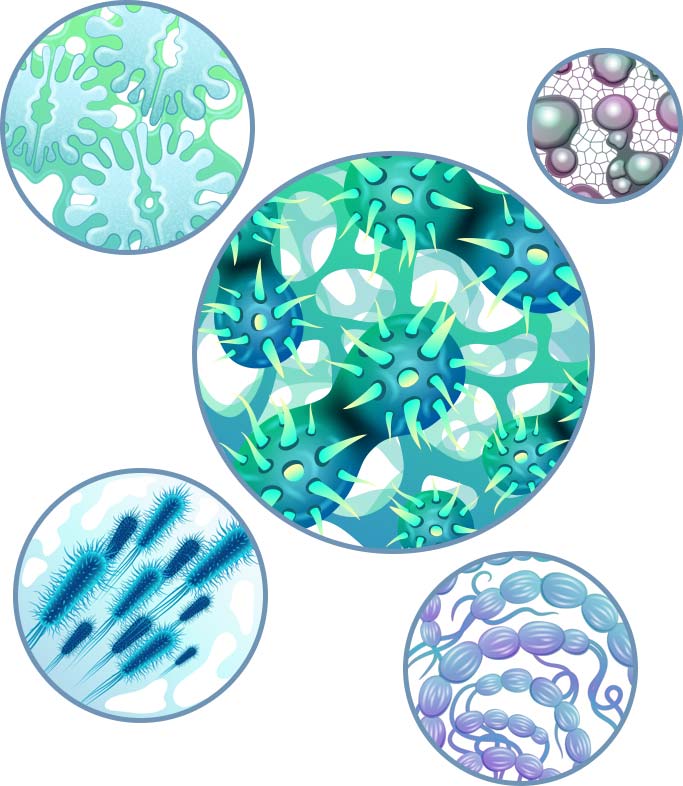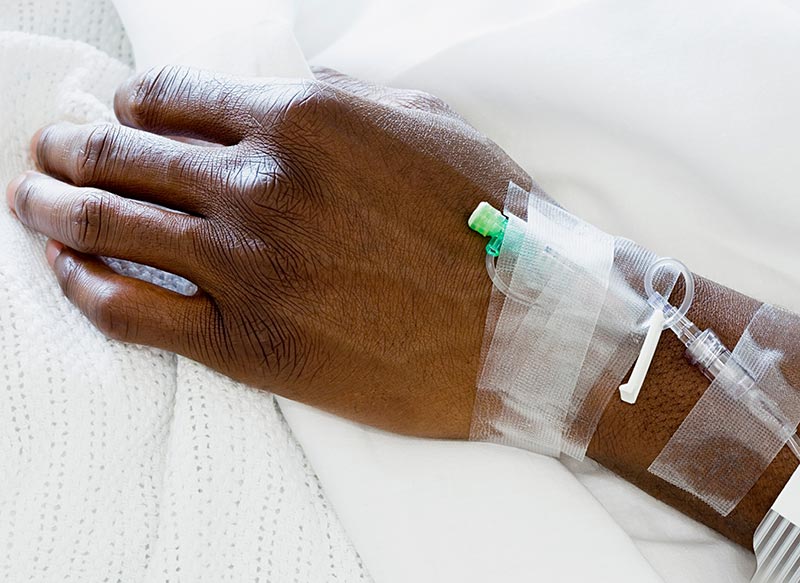About antibiotic-resistant skin and soft tissue infections
Find out more about skin and soft tissue infections and what happens when the antibiotics used to treat these infections no longer work. This includes infections such as cellulitis; skin, wound or surgical site infections; and infected diabetic ulcers.
The skin works as a barrier to prevent anything harmful getting inside the human body. It is colonised by many types of bacteria at all times – both the helpful and harmful. You can find out more on our bacteria and the body page. When bacteria manage to enter through a break in the skin, infection can occur. Sometimes it is not possible for the body’s immune system to fight off these infections.
There are several types of infection that can affect the skin. Most are easily treated but some can cause serious health problems or be life threatening when the bacteria involved are resistant to antibiotics.
If you or someone you care for has just been diagnosed with an antibiotic resistant skin or soft tissue infection, you are sure to have a lot of questions you would like answers to. We have tried to answer the most common ones below.
This page is for people who want to know about antibiotic-resistant skin and soft tissue infections. Visit our common infections page if you want general information about infections.

Who is at risk from antibiotic resistant skin and tissue infections?

Those at greatest risk of antibiotic resistant infections are often those with other underlying medical conditions, who have weakened immune systems either due to illness or as a side-effect of current treatment. These include the very young (including babies), the elderly, those on immunosuppressive drugs such as organ transplant patients, cancer patients undergoing chemo and radiotherapy and patients with genetic diseases such as cystic fibrosis.
Often, those affected have already been taking antibiotics or have been treated in hospital. Many of these resistant infections may be picked up during hospital stays. This is why it’s very important for staff, patients and visitors to wash hands well and keep surfaces/rooms clean. Bacteria are transmitted from person to person from contaminated handles and doorknobs, telephones and other equipment such as computer keyboards. Bacteria can also spread easily in crowded places such as care homes and community hubs like schools, colleges or childcare nurseries.
What type of bacteria usually cause antibiotic-resistant skin and tissue infections?
Find out more about bacteria in the human body. One of the most common antibiotic-resistant infections of the skin and soft tissue is Methicillin-resistant Staphylococcus aureus, or MRSA. This is a form of Staphylococcal infection that is not killed by the usual penicillin-type antibiotics. It is sometimes called a superbug. This term ‘superbug’ is commonly used for those bacteria which have become immune to antibiotics. With superbugs, bacterial growth can no longer be slowed down or stopped by antibiotics.
Cellulitis or surgical site infections are often caused by Gram-positive bacteria such as Staphylococcus aureus or Streptococcus pyogenes. Surgical site or wound infections that prove resistant to antibiotics are often tested and found to be due to mainly MRSA. Although, infections can also be due to Gram-negative bacteria such as E coli, Klebsiella, Pseudomonas or Acinetobacter. You can read more about Gram-postive and Gram-negative bacteria here.

What are the symptoms of an antibiotic-resistant skin and tissue infection?

The symptoms of an antibiotic-resistant skin and soft tissue infections are the same as those of a regular infection of this type. You can find out more about on our common infections page. The usual symptoms of wound infections or cellulitis are redness, heat, pain and inflammation in the affected areas. Sometimes people may have a fever – or feel hot and cold. This means their body is trying to fight the infection.
Where cellulitis is not responding to oral or even intravenous antibiotics, your clinical care team will often draw a line around the redness to trace whether the infection is spreading and how fast. This provides a guide as to whether the antibiotics are working, or the infection is getting worse and other action is required.
Resistant surgical site infections can occur on the body where patients have had an operation. They are often diagnosed by lack of healing and often accompanied by these same symptoms of tenderness, heat, and redness. However, doctors may need to grow the bacteria in a dish to find out which bacteria are causing the infection and what antibiotics will kill them.
Are antibiotic-resistant skin and tissue infections contagious?
While there is a risk that people around you could be exposed to the resistant bacteria causing your infection, it is unlikely they will become infected unless they have a weakened immune system or are in poor health. Good hygiene, such as thorough and frequent hand washing, is the most important thing that you, and those living with you, can do.
MRSA
Many people can carry these bacteria on their skin (or sometimes in their nose) without it causing any illness. If you are admitted to hospital, you may be tested for the presence of superbugs such as MRSA. This usually involves the doctor or nurse using a swab inside your nose and sending to the lab for testing. If you are a carrier of MRSA, you will be advised to let your healthcare staff know on admission to hospital. They may decide to separate you from other patients to help reduce the risk of other patients catching the infection. Healthcare staff will also take extra precautions by wearing gloves and washing hands frequently while treating you. This helps to reduce the risk of spreading a resistant infection to other patients too.
Whether at home or in hospital, it is recommended that you and those people you are in close contact with should maintain a good standard of hygiene (see ‘What can I do?’) and avoid sharing personal care items ( such as shavers, combs, makeup), towels and bedding. You can find more detailed information about MRSA here.

How are antibiotic-resistant skin and tissue infections usually treated?

In the hospital, MRSA and other resistant infections (such as surgical site infection where you may have an open wound due to an operation) are often treated with intravenous (IV) antibiotics reserved for those very resistant infections, until the infection begins to improve. You may then be required to continue taking antibiotics, in tablet form to complete the course. This course can often be completed at home. For patients requiring longer courses of IV antibiotics there may be an option for this to be administered outside hospital. You may be asked to visit healthcare professional or to attend an NHS facility each day, often referred to as Outpatient Parenteral Antimicrobial Therapy (OPAT).
In some cases of MRSA, your medical and nursing team may also require to drain pus from the site of infection. They may also treat the bacteria which can live in your nose or on the skin with a special ointment. This treatment aims to reduce the number of bacteria you are carrying in your body.
What happens if I have a multidrug-resistant skin, wound or soft tissue infection?
Hearing that your infection is resistant to antibiotics can be scary. If an infection is resistant to the antibiotics most often used to treat it, there will be others that can be used. In these types of infections, a swab may be used to test which bacteria are present and identify the best antibiotic(s) to treat the infection.
One of the major issues with all types of resistant infections is that if the infection spreads to the bloodstream it can cause a condition called sepsis. This is where the body’s immune response causes widespread inflammation, which can be life-threatening. That is why diagnosis and identification of a resistant infection as soon as possible is really important.

How quickly will the infection spread? Is there anything I can do to stop it getting worse?

The speed at which an infection spreads depends on many factors. This includes: the type of bacteria causing the infection, how long the infection has been present for, the genetics of the bacteria involved and the health and habits of the person affected. The best available advice is to maintain good personal hygiene. Avoid sharing towels, bedding or personal items like shavers and makeup. You should follow the advice of your doctor or clinical specialist. You should also let them know if you notice any changes in your condition.
What do I do if I have a question about antibiotic-resistant infections?
If your question is about your own health, please contact your GP or medical specialist treating you. Or, if you are feeling unwell but the problem is not a medical emergency, call 111 ( or your own local Out Of Hours telephone number). You can then find out whether you need to attend hospital. If you are experiencing a health emergency, you should call 999 or attend your nearest accident and emergency. Remember to take all of your medications with you.
If you are not seeking medical advice, but would like to talk to someone who understands antibiotic resistance and can help you find more information or provide a listening ear, get in touch with our Patient Support Officer, Arlene.
Contact Arlene on patient.support@antibioticresearch.org.uk or call her on 07367 784114. Calls are charged at your usual mobile or landline rate. However, you can request a call back from Arlene by text, email or by leaving a message.
Find out more
Explore our website to find out more about antibiotics, bacteria and the common infections they cause, and our research.

Patient Stories
Hear real patient stories from people that have suffered with antibiotic resistant soft tissue infections.
Disclaimer: Any medical information referred to in or through our website is given for information purposes only. It is not intended: to constitute professional advice for medical diagnosis or treatment; to replace consultation with a qualified medical practitioner; to advocate or recommend the purchase of any product; or to endorse or guarantee the credentials or appropriateness of any health care provider. You are strongly advised to consult with an appropriate professional for specific advice tailored to your situation. Instead, information provided on our website is intended to provide helpful signposting towards further information and support. It also aims to provide an opportunity for you to simply share and discuss matters relating to antibiotic resistance with our Patient Support Officer


